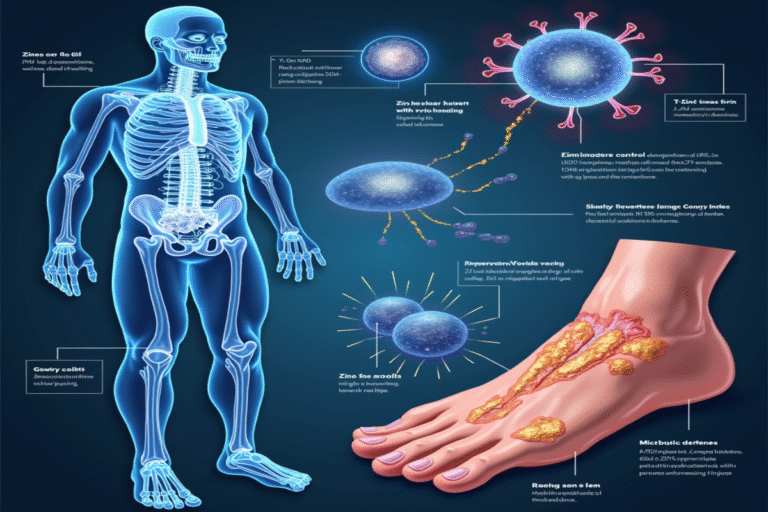Nestled in the periodic table with atomic number 30, zinc might seem like just another metal. But inside your body, this unassuming element orchestrates a remarkable symphony of biochemical processes that keep you healthy. Found in every tissue and fluid, zinc is the second most abundant trace mineral in your body after iron, yet many of us don’t fully appreciate its critical importance.
The Immune Guardian: How Zinc Mobilizes Your Defenses
When pathogens invade, zinc springs into action in ways that surprise even scientists. This mineral doesn’t just support your immune system—it’s essential to its very function.
At the molecular level, zinc influences gene expression in immune cells, helping them develop and work properly. Scientists have found that zinc acts as a signaling molecule, similar to neurotransmitters in the brain. During infection, zinc concentrations in immune cells change quickly, creating “zinc waves” that trigger advanced defense mechanisms.
The T-Cell Connection
One of zinc’s most important roles is with T-cells, specialized lymphocytes that identify and kill infected cells. Without enough zinc, T-cells can’t mature or function well. Research has shown that zinc deficiency can shrink your thymus gland (where T-cells develop) by up to 80%—weakening your entire adaptive immune system.
Zinc is also a structural component for about 750 transcription factors, including “zinc finger proteins” that regulate immune genes. These proteins grip DNA like tiny fingers, controlling which immune genes activate during infection.
Did you know? Your body has no specialized system to store zinc, so you need a steady dietary supply to keep your immune system strong.
The Wound Healing Accelerator
When your skin is injured, a complex healing process begins—and zinc is needed at nearly every stage:
- Inflammation: Zinc helps control inflammation, making sure there is enough to fight infection but not so much that it damages healthy tissue.
- Cell proliferation: Zinc is essential for DNA synthesis and cell division, letting new cells quickly replace damaged ones.
- Matrix metalloproteinases (MMPs): These zinc-dependent enzymes remodel the extracellular matrix, rebuilding the structure of the tissue.
- Collagen formation: Zinc is required for collagen synthesis, forming the structural framework of new tissue.
Another key aspect of zinc’s healing power is its direct action against microbes at wound sites. Zinc ions released during injury create a toxic environment for bacteria while stimulating immune cells. This dual effect is why zinc oxide has been used to treat wounds for centuries—long before science understood its function.
The Molecular Dance of Zinc Transport
How does your body deliver this vital mineral where it’s needed most? Two protein families are responsible: ZIP transporters (which move zinc into cells) and ZnT transporters (which move zinc out of cells or into cell compartments).
During immune activation, these transporters temporarily shift zinc throughout your body—a process scientists call “nutritional immunity.” This deprives invading microbes of zinc they need, while making sure your immune cells have enough to mount a defense.
Beyond Oysters: Where Your Zinc Comes From
Oysters contain more zinc per serving than any other food, but red meat and poultry are also excellent, easily absorbed sources. Plant foods like legumes, nuts, and whole grains also provide zinc, but it is bound to phytates—compounds that can reduce absorption.
Traditional food preparation techniques such as fermentation, sprouting, and soaking can break down phytates, making zinc more available from plant foods. Cultures around the world have used these methods for centuries to improve nutrition.
The Cutting Edge of Zinc Research
Scientists are still discovering new roles for zinc in human health. Recent studies suggest zinc may affect:
- Diversity and health of the gut microbiome
- Neuronal signaling and mental function
- Regulation of chronic inflammation
- Inhibition of viral replication, including fighting respiratory infections
Some emerging evidence shows that genetic differences in zinc transporters may explain why people respond differently to zinc supplements during illness.
As our understanding grows, one thing stays clear: the humble zinc atom, with its 30 protons and electrons, makes possible life-sustaining chemistry in your body, rivaling the most advanced laboratory work ever achieved.





